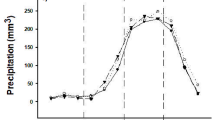Summary
-
1.
The contributions made by changes in dermal reflectance and dermal vascularity to temperature regulation have been studied in the agamid lizardAmphibolurus nuchalis with the use of85Kr and133Xe.
-
2.
Skin reflectivity varied directly with the body temperature, increasing at elevated body temperatures which decreased the rate of absorption of radiant energy. Decreases in body temperature below the preferred are accompanied by decreases in reflectance which increase the rate of absorption of radiant energy.
-
3.
Subcutaneous blood flow varied directly with the body temperature when measured under conditions of thermal stability. This temperature-dependent increase in dermal blood flow is interpreted as a machanism facilitating the transfer of heat between the core and the periphery of the animal.
-
4.
Peripheral blood vessels demonstrate the capacity to autoregulate and may dilate during basking as a result of local heating, facilitating the increase in dermal blood flow.
-
5.
Dead α-MSH-injected animals heated at a faster rate than dead hypophysectomised animals, suggesting that local heating of the skin due to low reflectance is a major factor responsible for increased subcutaneous blood flow during heating.
Similar content being viewed by others
Abbreviations
- α-MSH :
-
melanophore stimulating hormone
- SBF :
-
subcutaneous blood flow
References
Abdel-Dayem, H.M.: Handling of radioactive133Xe dissolved in saline. J. Nucl. Med.13, 231 (1972)
Atsatt, S.R.: Color changes as controlled by temperature and light in the lizards of the desert regions of Southern California. Univ. Calif. Publ. Biol. Sci.1, 237–276 (1939)
Bagnara, J.T., Hadley, M.E.: Chromatophores and color change. New York: Prentice-Hall 1973
Baker, L.A., Weathers, W.W., White, F.N.: Temperature induced peripheral blood flow changes in lizards. J. Comp. Physiol.80, 313–323 (1972)
Bakken, G.S.: A heat transfer analysis of animals: unifying concepts and the application of metabolism chamber data to field ecology. J. Theor. Biol.60, 337–384 (1976)
Bartholomew, G.A., Lasiewski, R.C.: Heating and cooling rates, heart rates and simulated diving in the Galapagos marine iguana. Comp. Biochem. Physiol.16, 573–582 (1965)
Bartholomew, G.A., Tucker, V.A.: Control of changes in body temperature, metabolism and circulation by the agamid lizardAmphibolurus barbatus. Physiol. Zool.36, 199–217 (1963)
Bartholomew, G.A., Tucker, V.A.: Size, body temperature, thermal conductance, oxygen consumption, and heart rate in Australian Varanid lizards. Physiol. Zool.37, 341–354 (1964)
Bartholomew, G.A., Tucker, V.A., Lee, A.K.: Oxygen consumption, thermal conduction and heart rates in the Australian shinkTiliqua scincoides. Copeia1965, 169–173 (1965)
Bogert, C.M.: How reptiles regulate their body temperature. Sci. Am.200, 105–120 (1959)
Bradshaw, S.D., Main, A.R.: Behavioural attitudes and regulation of temperature inAmphibolurus lizards. J. Zool.154, 193–221 (1968)
Bradshaw, S.D., Waring, H.: Comparative studies on the biological activity of melanin-dispersing hormone (MDH). In: La spécificité zoologique des hormones hypophysaires et de leurs activités. Colloque du Centre National de la Recherche Scientifique, Paris, No. 177, pp. 135–152. Fontaine, M. (ed.). 1969
Cole, C.L.: Experiments on toleration of high temperature in lizards with reference to adaptive coloration. Ecology24, 94–108 (1943)
Cowles, R.B.: Possible origin of dermal temperature regulation. Evolution12, 347–357 (1958)
Heatwole, H.: Thermal ecology of the desert dragonAmphibolurus inermis. Ecol. Monogr.40, 425–457 (1970)
Kleinholz, L.H.: Studies in reptilian colour changes. II. The pituitary and adrenal glands in the regulation of the melanophores ofAnolis carolinensis. J. Exp. Biol.15, 475–491 (1938)
Morgareidge, K.R., White, F.N.: Nature of heat-induced cutaneous vascular response inIguana iguana. Physiologist12, 306 (1969a)
Morgareidge, K.R., White, F.N.: Cutaneous vascular changes during heating and cooling in Galápagos marine iguana. Nature223, 587–591 (1969b)
Noble, G.K., Bradley, H.T.: The relation of the thyroid and the hypophysis to the moulting process in the lizardHemidactylus brookii. Biol. Bull.64, 289–298 (1933)
Norris, K.S.: Color adaptation in desert reptiles and its thermal relationships. In: Lizard ecology: A symposium. Milstead, W.W. (ed.), pp. 162–220. Columbia, Miss: University of Missouri Press 1967
Parker, G.H.: The color changes in lizards, particularly inPhrynosoma. J. Exp. Biol.15, 48–73 (1938)
Pearson, O.P.: The effect of substrate and of skin colour on thermoregulation of a lizard. Comp. Biochem. Physiol.58A, 353–358 (1977)
Porter, W.P.: Solar radiation through the living body wall of vertebrates with emphasis on desert reptiles. Ecol. Monogr.37, 273–296 (1967)
Waring, H.: Colour change mechanisms of cold-blood vertebrates. New York, London: Academic Press 1963
Weathers, W.W.: Physiological thermoregulation in the lizardDipsosaurus dorsalis. Copeia1970, 549–557 (1970)
Weathers, W.W.: Some cardiovascular aspects of temperature regulation in the lizardDipsosaurus dorsalis. Comp. Biochem. Physiol.40A, 503–515 (1971)
Author information
Authors and Affiliations
Rights and permissions
About this article
Cite this article
Rice, G.E., Bradshaw, S.D. Changes in dermal reflectance and vascularity and their effects on thermoregulation inAmphibolurus nuchalis (reptilia: Agamidae). J Comp Physiol B 135, 139–146 (1980). https://doi.org/10.1007/BF00691203
Accepted:
Issue Date:
DOI: https://doi.org/10.1007/BF00691203




